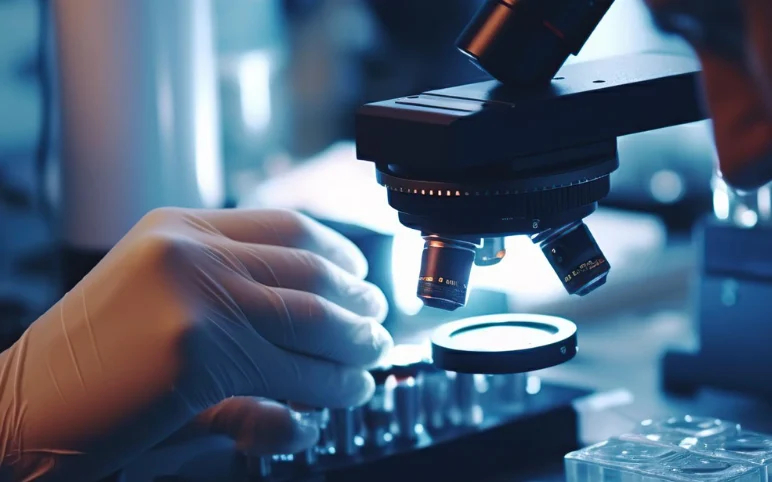Nanobots in medicine and healthcare represent one of the most promising frontiers in modern science, poised to revolutionize diagnosis, treatment, and patient monitoring at a molecular level. These microscopic machines, often referred to as nanobots, nanorobots, or medical nanobots, are engineered to operate within the human body, offering unprecedented precision and control for a wide range of medical applications.
What are Nanobots?
Nanobots, also known as medical nanobots, nano medical robots, or nanorobots, are microscopic devices typically ranging from 1 to 100 nanometers in size, often smaller than the width of a human hair. Designed to operate within the human body, these advanced machines can detect diseases, deliver targeted medications, and even carry out cellular-level repairs.
Constructed from biocompatible materials such as DNA, proteins, or synthetic polymers, nanobots are engineered with miniature components including sensors, actuators, drug reservoirs, and onboard processing units. These allow them to autonomously or semi-autonomously navigate the bloodstream and interact with specific cells or tissues. Control mechanisms may include external inputs such as magnetic fields, ultrasound, or light, enabling precise manipulation and navigation.
The integration of nanobots in the medical field represents a revolutionary leap in personalized and precision medicine. By reaching even the most inaccessible areas of the body, they offer significant potential in early disease detection, minimally invasive treatment, and real-time monitoring, ushering in a new era of smart therapeutics.
Medical Applications of Nanorobots: The Transformative Potential of Nanobots in Medicine
The field of nanorobotics in medicine is rapidly evolving, offering groundbreaking applications that could revolutionize healthcare. These microscopic devices, nanobots, medical nanobots, or nanorobots, are enabling precise, minimally invasive, and highly efficient medical interventions. Key applications include:
- Targeted Drug Delivery: Nanobots can deliver therapeutic agents directly to diseased cells or tissues, such as tumors or inflamed areas, minimizing side effects and maximizing treatment efficacy. This precision ensures better outcomes with reduced systemic exposure.
- Advanced Diagnostics and Monitoring: Functioning as early detection systems, nanobots can identify abnormal cellular activity, detect disease biomarkers, and continuously monitor physiological parameters in real time. This enables proactive medical interventions and personalized treatment strategies.
- Enhanced Medical Imaging: These nanoscale devices can act as contrast agents to improve the resolution and clarity of imaging techniques like MRI or CT scans, aiding in accurate diagnosis and treatment planning.
- Gene Therapy: Nanorobots can deliver genetic material precisely to targeted cells, supporting the treatment of inherited or acquired genetic disorders by repairing or replacing faulty genes.
- Regenerative Medicine and Wound Healing: Nanobots can stimulate tissue repair, support cell regeneration, and accelerate wound healing processes, making them vital tools in regenerative medicine and recovery from injuries.
- Nanobots in Blood: Deployed within the bloodstream, nanobots can detect and respond to clot formations, infections, and chemical imbalances, maintaining real-time surveillance and enhancing patient safety.
- Minimally Invasive Surgery: Some nanobots are being engineered to perform microscale surgical procedures, reducing trauma, minimizing scarring, and shortening recovery times by operating at the cellular level.
- Artificial Blood Components: Cutting-edge nanorobots such as respirocytes (artificial red blood cells) and clottocytes (synthetic platelets) are being developed to efficiently transport oxygen and rapidly stop bleeding, offering superior performance compared to natural blood components.
These examples illustrate just a fraction of the vast possibilities that nanobots in the medical field can offer.
Nanobots for Cancer Treatment
Nanorobotics, a cutting-edge subfield of nanotechnology, focuses on the design and development of microscopic machines capable of operating at the atomic, molecular, and cellular levels. These nanorobots, often smaller than a single blood cell, are engineered to circulate through the human bloodstream, equipped with advanced sensors capable of identifying specific molecular markers. This makes them highly suitable for diagnosing and treating complex diseases, including cancer.
One of the most promising and actively researched applications of nanorobotics is in cancer therapy. Traditional treatment methods, such as chemotherapy, are often imprecise, with studies showing that up to 99% of chemotherapy drugs fail to reach cancer cells, instead damaging healthy tissue and causing severe side effects. In contrast, medical nanobots, which are up to 100 times smaller than human cells, offer the potential to target and destroy cancer cells with pinpoint accuracy.
Researchers are already testing DNA-based nanorobots in preclinical models. These programmable DNA strands can navigate the bloodstream and deliver clot-inducing drugs specifically to the blood vessels feeding tumors, effectively cutting off their nutrient supply. In other experimental approaches, nanobots have been designed to deliver radioactive substances or chemotherapy agents directly to cancerous cells, even across difficult-to-penetrate areas like the blood-brain barrier.
Unlike conventional treatments, where only the therapeutic outcome is measured, nanorobotics introduces an added layer of complexity. Scientists must understand not just whether the nanobot works, but how it moves, interacts, and performs its tasks within the body. This remains a significant challenge, as real-time observation is limited. However, advances in computer modeling and simulation are beginning to bridge this gap, allowing researchers to predict nanobot behavior with increasing accuracy.
While nanorobotics in cancer care is still in its early stages, it represents a promising complement to existing therapies. Emerging treatments like immunotherapy are currently more advanced in clinical application, but nanobots offer a uniquely versatile and targeted approach that could revolutionize how we treat cancer in the future.
Encouragingly, the progress being made reflects a growing commitment to solving long-standing medical challenges. With continued research and development, nanobots in medicine may soon shift from theoretical to therapeutic, transforming cancer from a life-threatening illness into a manageable, chronic condition.
As the science of nanorobotics in medicine advances, the integration of nanobots in humans holds the promise of transforming diagnostics, treatment, and long-term health management, bringing us closer to a new frontier of precision, personalized, and predictive medicine.
Advantages of Nanobots in Healthcare
The advantages of nanobots in healthcare include:
- Minimally Invasive Procedures: Reducing the need for surgeries.
- Precision Medicine: Tailored treatment based on individual molecular profiles.
- Real-Time Monitoring: Continuous data collection on patient health.
- Early Disease Detection: Recognizing illness at the molecular level.
- Enhanced Drug Delivery: More effective dosages with fewer side effects.
As nanobot medical applications become more sophisticated, patient outcomes and system efficiencies are expected to improve significantly.
Challenges in Building and Deploying Nanobots
While the potential of nanobots in the medical field is immense, several critical challenges must be addressed before they can be widely adopted in clinical practice:
- Technical Complexity: Engineering nanobots to navigate the intricate and dynamic environment of the human body demands breakthroughs in miniaturized sensors, advanced materials, and propulsion mechanisms. Achieving precise control, communication, and task execution at the nanoscale remains a significant hurdle.
- Power Supply: One of the most pressing limitations is developing a reliable, safe, and long-lasting power source. Nanobots must operate autonomously inside the body without generating heat or toxic byproducts, all while maintaining sufficient energy for complex tasks.
- Biocompatibility and Safety: Medical nanorobots must be non-toxic, non-immunogenic, and compatible with human tissues. Ideally, they should either degrade naturally after completing their function or be safely excreted or retrieved without causing harm.
- Regulatory and Ethical Considerations: The clinical use of nanobots is subject to stringent regulatory scrutiny to ensure safety and efficacy. Additionally, ethical considerations surrounding autonomy, long-term effects, and equitable access must be addressed. Varying regulations across regions also pose challenges for standardization and global deployment.
- Data Security and Privacy: As nanobots collect and transmit real-time health data, ensuring the security and confidentiality of sensitive patient information is crucial. Robust cybersecurity frameworks must be in place to prevent data breaches or misuse.
- High Research and Development Costs: The design, testing, and manufacturing of nanobots require significant financial investment and multidisciplinary collaboration, which can slow down commercialization and accessibility.
Overcoming these obstacles will require coordinated efforts across nanotechnology, medicine, bioengineering, ethics, and policy. Nevertheless, as innovations continue to emerge, the path toward safe and effective nanobots in humans becomes increasingly tangible.
Overcoming the Challenges of Nanobots
Researchers and developers are actively working to overcome these hurdles:
- Biodegradable Materials: Ensuring safe breakdown and removal from the body.
- Advanced Materials: Using graphene, gold nanoparticles, and DNA origami for efficient design.
- Miniature Power Systems: Development of wireless or body-heat-powered systems.
- Global Regulatory Alignment: Harmonizing international standards for faster approval.
Industry collaboration, funding, and public-private partnerships are accelerating the journey of nanobots in the medical field from lab to clinic.
Market Size and Emerging Regions
The nanobots/nanorobots market was valued at USD 6,724.22 million in 2024, growing at a CAGR of 14.50% during the forecast period from 2025 to 2032 to reach USD 19,759.22 million by 2032. Key nano robots market drivers include:
- Growth in chronic diseases like cancer and diabetes.
- Demand for minimally invasive surgery.
- Technological innovation in nanomaterials.
In 2024, North America dominated the global nanorobots market. This leadership is attributed to substantial investments in nanorobotics, particularly aimed at developing commercial applications in healthcare and advanced manufacturing. Moreover, strong collaboration between government agencies and private-sector firms is fostering innovation and accelerating the path to commercialization.
Meanwhile, emerging regions such as Asia-Pacific and the Middle East are rapidly gaining prominence in the nanobots market, especially in applications like diagnostics and regenerative medicine. These regions are increasingly investing in infrastructure and R&D to support technological adoption.
From a product perspective, growth in these regions is being driven by a focus on advanced nanobot platforms, including targeted drug delivery systems and surgical nanodevices, highlighting their strategic push toward next-generation medical technologies.
Nanobots Market Dynamics
The nanorobotics in healthcare market is experiencing rapid growth, driven by advances in nanotechnology and increasing demand for precision medicine. The global nano robots market is projected to expand significantly in the coming years, with applications spanning oncology, cardiology, neurology, and regenerative medicine. Key factors fueling market growth include:
- Technological Innovation: Advances in materials science, robotics, and biotechnology are enabling the development of increasingly sophisticated nanorobots.
- Rising Healthcare Needs: The growing prevalence of chronic diseases and the demand for less invasive treatments are driving adoption.
- Investment in Research: Governments, academic institutions, and private companies are investing heavily in the development of nanobot medical technologies.
Emerging regions such as Asia Pacific, North America, and Europe are leading the way in research and commercialization, with significant investments in both product development and clinical trials.
Leading Players in the Nanobot Market
A wide range of companies, ranging from multinational giants to niche technology specialists, are currently active in the nanorobotics market. These firms are driving innovation through R&D, strategic collaborations, and technological advancements. Notable players include:
Leading MedTech and Nanotechnology Companies:
- Thermo Fisher Scientific: A global leader in scientific instrumentation and diagnostics, investing in nanoscale imaging, drug delivery systems, and molecular biology tools.
- Bruker Corporation: Specializes in high-performance analytical and imaging instruments used in nanotechnology research and applications.
- JEOL Ltd.: A key provider of electron microscopes and analytical instruments, facilitating nanostructure analysis and development.
- Oxford Instruments: Offers advanced nanofabrication, imaging, and analysis solutions for academic and industrial nanotechnology users.
- Agilent Technologies, Inc.: Delivers high-precision instruments and software for life sciences and nanotech-based applications.
Emerging Innovators and Niche Specialists:
- Xidex Corp.: Focused on nanorobotics development for commercial applications, including nanomanipulation and medical diagnostics.
- Zymergen Inc.: Combines nanotechnology, biology, and AI to design materials and therapeutics with nanoscale precision.
- Synthace Limited: Pioneers digital biology platforms that interface with nanotechnologies to optimize synthetic biology workflows.
- Kleindiek Nanotechnik GmbH: Specializes in micro- and nanorobotic tools for positioning and manipulation within research and industrial settings.
- Toronto Nano Instrumentation: Develops custom nanoinstrumentation for medical and scientific research.
- Advanced Diamond Technologies: Utilizes nanocrystalline diamond technology in biomedical coatings and devices.
- Advanced Nano Products Co., Ltd.: Provides nano-based products and materials, including those used in drug delivery systems.
- Ginkgo Bioworks: Integrates nanotechnology with synthetic biology to design customized microbes for healthcare and industrial use.
Instrumentation and Imaging Leaders:
- Park Systems: Offers atomic force microscopy tools for nanoscale surface characterization.
- NT-MDT SI: A recognized provider of scanning probe microscopes for nanotechnology research.
- AIXTRON: Supplies deposition systems for nanomaterial fabrication, particularly in semiconductors and bio-nano interfaces.
- Nanonics Imaging Ltd.: Develops advanced nanoscopy tools for real-time imaging and manipulation.
- Imina Technologies SA: Produces robotic solutions for precise movement and control at the nanoscale.
- EV Group (EVG): Provides wafer bonding and lithography systems essential for nanofabrication in medical devices.
Other Active Players in the Nanobots Ecosystem:
- WITec GmbH
- Cavendish Kinetics, Inc.
- Angstrom Advanced Inc.
These companies are actively engaged in R&D, commercialization, and strategic collaborations aimed at bringing nanobot-enabled technologies to the forefront of medical care. Efforts include partnerships with research institutions, pharmaceutical companies, and government bodies to accelerate clinical translation and regulatory approvals.
Future of Nanobots in Healthcare
The future of nanobots in healthcare holds transformative potential, with ongoing innovations aimed at enhancing their precision, functionality, and safety. As the field of nanorobotics in medicine continues to evolve, these microscopic tools are expected to become integral to routine diagnostic and therapeutic practices. In particular, their use in detecting and treating complex diseases such as cancer is anticipated to become increasingly widespread, improving outcomes through highly targeted intervention.
One of the most promising developments lies in the integration of nanobots with artificial intelligence and advanced robotics. This synergy will allow nano-medical robots to make autonomous decisions, adapt to real-time conditions within the body, and deliver therapies with unprecedented accuracy. AI-enabled nanobots could revolutionize how diseases are monitored and treated, reducing the need for human intervention and enabling faster response times.
Nanobots are also poised to drive forward the era of personalized medicine. By interacting directly with a patient’s unique genetic and molecular profile, they can deliver custom-tailored treatments at the cellular level. This degree of personalization could lead to more effective therapies with fewer side effects, particularly in areas like oncology and chronic disease management.
Beyond oncology and surgery, the scope of medical nanobots is expanding into new frontiers, including the treatment of infectious diseases, tissue regeneration, and interventions aimed at slowing or reversing the effects of aging. As research progresses and regulatory pathways are clarified, nanobots are expected to redefine the landscape of modern medicine, offering minimally invasive, highly targeted, and responsive solutions across a wide range of health conditions.
Frequently Asked Questions (FAQs)
1. What are nanobots?
Nanobots are microscopic robots, usually ranging from 1 to 100 nanometers in size, designed to perform specific tasks in the human body, such as drug delivery, diagnostics, and cellular repair.
2. Are nanobots being used today?
While full clinical use is still under development, several preclinical trials and laboratory studies are underway, particularly for cancer therapy and drug delivery.
3. When will nanobots be used in medicine?
Experts predict that nanobots could see mainstream medical use within the next 5–10 years, depending on technological progress and regulatory approvals.
4. What are nanobots used for?
They are used for targeted drug delivery, disease diagnosis, internal surgeries, gene therapy, and real-time health monitoring.
5. What are nanorobots?
Nanorobots are a broader term encompassing all nanoscale robotic systems, including nanobots, designed for specific biological tasks.
6. How are nanobots made?
Nanobots are made using nanotechnology techniques such as DNA origami, molecular self-assembly, and microelectromechanical systems (MEMS), often incorporating biocompatible materials like gold, silicon, or synthetic polymers.



